Top Info For Choosing application development with Low-code platforms
Wiki Article
The Benefits Of Low-Code Programming For Developing Applications As It Relates To Integration Capabilities
Low-code applications offer significant advantages in the area of integration capabilities, which are essential for creating applications that can seamlessly integrate with different platforms and services. These are the advantages of APIs and connectors that are pre-built:
An extensive range of connectors. Low-code systems usually include a wide range of pre-built connections for enterprise systems that are popular (e.g. cloud-based services, databases, CRM). This eases the process of integrating with these systems.
API Integration: A lot of low-code platforms offer API integration features, allowing developers to connect to other services and data sources easily.
Easy to Utilize:
Drag-and–Drop Interfaces: Many integration tasks can be easily completed using drag-and–drop interfaces. This makes it feasible for developers and others who are not developers to create complex systems without extensive coding.
Visual Workflow Builders Visual tools to create workflows and data flows aid in understanding and establishing integrations more intuitively.
Standardized Integration Methods:
SOAP and Restful Services: Supporting standard web service protocols like SOAP and REST makes it easy to connect external systems and applications.
OData and other Standards Support for standards like OData allows access and manipulation of data across platforms and applications.
Real-Time Data Synchronization:
Low-code platforms allow for real-time integrations between systems and applications. This allows data to be consistent and updated across all departments of the business.
Event-Driven Architect: A few platforms have events-driven structures, allowing applications to react instantly to any event. This is essential in dynamic interactive applications.
Legacy System Integration:
Low-code platforms: These can be utilized to connect legacy systems to the latest. They're an excellent way to modernize your IT infrastructure without the need to completely overhaul your IT infrastructure.
Data Migration Tools: These built-in instruments for data migration facilitate the transfer of old systems to new applications built using low-code platforms.
Third-Party Service Integration:
Cloud Services: Seamless Integration with Cloud Services such as AWS Azure Google Cloud and Google Cloud makes it easy to deploy applications.
Business Applications Integration: Low code platforms can be integrated with different business applications like Salesforce, SAP and Microsoft Dynamics. This creates a seamless workflow between the business functions.
Simplified data management:
Unified Data Models Some low-code platforms have unification of data models which make it easier to manage data management and integration across multiple systems.
Data Connectors Pre-configured data connectors enable users to access and manipulate data gathered from many sources.
Security and compliance:
Secure Integrations: Low-code platforms guarantee that integrations adhere to security protocols as well as standard security standards, securing data in transportation as well as during rest.
Compliance Features: These platforms include features that ensure integrations comply with regulatory requirements (e.g. GDPR, HIPAA), giving businesses who handle sensitive data security.
Extensibility:
Low-code platforms often meet complex integration needs by including custom code or scripts. They allow for flexibility without compromising the accessibility.
Plug-in Ecosystem : An ecosystem of plugins and extensions that will enhance integration capabilities through allowing users to create new features as needed.
Low-code platforms provide a powerful instrument to create interconnected efficient and scalable apps. These platforms simplify the process of integrating various IT systems, improve the flow of information, and assist businesses to adopt the latest technologies while also leveraging new ones. Read the top rated Low-code Platform for application development for website examples including develop web application, azure sql server, cross platform mobile app development, app modernization, rapid action development, develop cross platform mobile app, app development platform, cross platform app dev, app modernization, software for app development and more.

The Advantages Of Low-Code Development In Terms Of Flexibility, Scalability And Scalability
Low-code development can bring many benefits in regards to scalability and flexibility essential to developing applications that can be capable of growing and adapting with changing business requirements. These are the main benefits:
Cloud-Based Deployment. Many low-code platforms feature cloud-based deployments that allow the scaling of applications by using cloud infrastructure. Businesses can handle greater load without worrying too much about server administration.
Auto-Scaling Features: Built-in auto scaling features automatically adjust resources in accordance with the demand. This provides constant performance during peak times, without manual intervention.
Flexible Architecture:
Modular design Low-code platforms are a fantastic way to encourage modular applications. These allow components to be designed and developed on their own, tested, scaled, etc. This allows for greater flexibility and makes it possible to upgrade or expand certain parts of the application without affecting other components.
Microservices Integration Microservices support allows applications to be developed by combining loosely coupled services, enhancing both scalability and flexibility.
Customizable Solutions
Flexibility : Low-code platforms permit developers to extend capabilities beyond what is available in standard features. This allows the fulfilment of unique business needs without limitations.
Third-Party Integrations: The ability of businesses to integrate APIs and applications from third parties and add new functions to the application when needed, enhances its capabilities.
Agile Development Deployment, Agile Development Agile Development:
Continuous Delivery and Deployment : Low-code platform support agile methodologies enabling continuous integration, continuous delivery (CI/CD). This allows for the rapid deployment and updates of new features.
Iterative Development - This low-code method permits applications to be upgraded and scaled gradually, reducing risk and allowing for more controlled expansion.
Resource Optimization
Effective resource management: Low code platforms optimize resources by offering tools to monitor and control application performance. This lets resources be utilized efficiently and also to be increased or decreased based on the actual need.
Load-balancing: Features that spread workloads equally across servers improve the ability of an application to handle large volumes of traffic and ensure consistent performance.
Global Reach
Multi-Region Deployment: Low code platforms generally support deployment across multiple geographic regions, enabling companies to offer low-latency connectivity to users around the world. This is particularly important when applications have a global user base.
Support for Localization The built-in support for localization allows the applications to be easily customized to suit various languages and needs in diverse markets.
Maintenance and Updates
Maintenance is easy by the visual nature and modularity of low-code applications makes maintenance easier, allowing for quick updates and bugfixes to be implemented without lengthy downtime.
Version Control System for Version Control: These integrated versions oversee rollbacks and changes in order to make sure that upgrades can safely be made and that older versions can be restored if needed.
Cost Efficiency:
Lower development costs: By reducing the need for a lot of coding, low-code platforms lower development costs and allow to scale applications without a significant increase in development effort and expense.
Pay-As you Go Models A lot of platforms for low-code offer flexible pricing options, like pay-as we-go models that align costs and usage with actual growth.
The ability to scale low-code applications permits businesses to create robust, adaptable, scalable, and robust applications. These platforms permit quick adaption to evolving requirements as well as efficient utilization of resources and continuous improvement. This means that the applications are able to grow along with the company. See the top Legacy application modernization with Low-code examples for website recommendations including mobile development platforms, cloud software applications, app modernisation, application modernization software, multiplatform mobile app development, develop web application, application development platforms, ms azure sql, cross platform app development, application modernization software and more.

The Advantages Of Low-Code Development For Developing Applications, In Terms Of Restrictions And The Possibility Of Customization
Low-code application development offers an approach that is balanced and offers significant advantages in terms of addressing limitations and allowing for customization. Here are some of the key benefits.
Overcoming Complexity Barriers:
Low-code development platforms are easier to use due to the fact that they come with already-built components, templates and other tools. They also facilitate rapid deployment of even the most complicated applications.
Many platforms have wizards and workflows with guided steps to aid developers in understanding complicated processes. These tools minimize the chances of errors, and help ensure uniformity.
Solutions to scale:
Built-in Scalability: Low code platforms have many features that allow for an architectural design that is scalable, allowing applications to take on a greater demand without requiring significant changes.
Performance Monitoring: Tools which monitor and optimize performance can help ensure that applications are efficient even as they expand.
Security and Compliance
Integrated Security Features: Low-code platforms have security features built-in like encryption, access control based on role and automated checks for compliance to address security issues that are common.
Platforms are regularly updated with their security and compliance measures to ensure that applications are safe from new threats.
Customization Features:
Extensibility:
Low-code platforms allow developers to extend functionality beyond standard offerings by integrating customized code.
Developers are able to create custom modules and plugins with functions that can be specifically tailored to meet the needs of specific businesses.
APIs and Integration:
API Support: Comprehensive support for APIs allows seamless integration with other systems and services. This allows for customizing and connectivity.
Third-Party Services: Low code platforms have connectors built for popular third party services. This makes it much easier to build and integrate applications.
Flexible Design for UI/UX
Customizable User Interfaces: Developers are able to modify and create user interfaces that comply with the requirements for branding and usability, creating a tailored user's experience.
Responsive Design: Built-in responsive design capabilities ensure that applications can be customized for various screens and devices.
Custom Business Logic for Businesses:
Visual Workflow Builds Visual tools that permit customization of workflows and business rules, and also to create complex, tailored procedures.
Conditional Logic and scripting: Platforms allow for the use of conditional logic, and scripting that is custom-made to handle specific business rules.
Data Management
Custom Data Modelling: Those who develop the models develop custom models to meet specific requirements for the particular application. They can customize data handling to the business's requirements.
Advanced Data Processing: The integration of advanced tools and capabilities for data processing permits customizations to the way data is analyzed within an application.
Balance Customization and Limitations:
Frameworks and Standards:
Best Practices: Low-code platform promotes conformity to standards and industry best practices. This helps in maintaining high quality apps that are scalable, secure and reliable.
Governance Frameworks Governance Frameworks: Integrated governance frameworks ensure that the customizations do not interfere with the integrity, conformity, or security of the application.
Iterative Design and Feedback
Rapid prototyping: The ability to quickly prototype and test customizations ensures that developers can iterate based on user feedback, refining the application to better satisfy the user's needs.
Low-code platforms enable continuous improvement, allowing for continuous customization and further enhancing as business requirements develop.
Users Empowerment
Low-code platforms allow citizen developers to develop by allowing non-developers with intuitive interfaces, to personalize applications, they increase the pool of developers who can modify and enhance applications.
Support and Training Resources: Many platforms provide comprehensive training and support materials to allow users to customize their applications without jeopardizing their functionality or stability.
Overall, application development that is low-code offers a robust system for dealing with limitations, and offers a wide range of possibilities to customize. This balance enables businesses to build and maintain apps that function, are tailored to their particular requirements and adhere to high standards in terms of security, quality and scalability.
